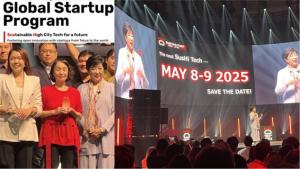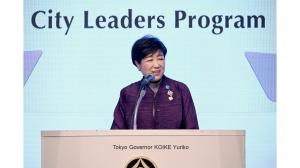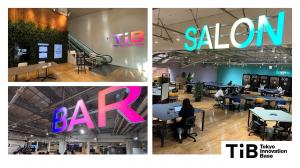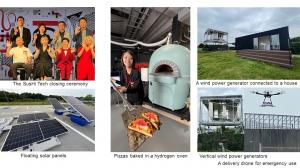TOKYO, JAPAN, June 18, 2024 /EINPresswire.com/ -- SusHi Tech Tokyo 2024 has closed after drawing more than 600,000 visitors to an array of technology-driven attractions over a month in the fast-developing Tokyo Bay area. But the beat goes on with tests on even more future technologies designed to build a sustainable megacity. https://www.sushi-tech-tokyo2024.metro.tokyo.lg.jp/
The event has also bustled with a gathering of global startups and a summit of the leaders of 45 cities from five continents. The startup program brought together a total 40,000 participants, according to organizers, living up to its billing as one of Asia’s largest global innovation conferences. “I think this has certainly provided a good chance for people, including many children, to visualize and think about the future,” Vice Tokyo Governor NAKAMURA Rinji told the SusHi Tech closing ceremony on May 26. The Tokyo Metropolitan Government (TMG) put the total turnout at more than 600,000.
The TMG is preparing to host the next edition of SusHi Tech Tokyo, which stands for Sustainable High City Tech Tokyo, a year from now. And presumably, the best is yet to come.
In the land-filled Central Breakwater area, the metropolitan government has been supporting startups in testing cutting-edge technologies for two years - including flying vehicles and new-look solar and wind power generators. The number of annually appointed pilot projects for social implementation has reached 15.
Startups and city leaders join up
In its third week, the SusHi Tech event concurrently featured the Global Startup Program and the City Leaders Program in addition to the month-long Showcase Program
https://sushitech-startup.metro.tokyo.lg.jp/en/
https://www.g-nets.metro.tokyo.lg.jp/en/
More than 430 startup companies as well as 48 countries, regions and cities set up booths at the waterfront Tokyo Big Sight convention hall. They mingled with a wide range of domestic and overseas players such as startups, venture capital investors, big businesses and cities.
Governors, mayors and other municipal executives also had a first-hand look of the startup program, taking a timeout from their summit at a downtown hotel aimed at solving common urban challenges and creating a sustainable world. Helsinki and Nairobi each staged a “reverse pitch” to invite startups to join them, respectively, in mitigating environmental burden and establishing communication in the event of flooding.
In a communique, the city leaders vowed to utilize the “technologies of startups to find solutions to urban challenges” on top of “intercity technological exchanges aimed at sharing wisdom and expertise.” Tokyo plans to host the next City Leaders summit in 2026 with a preparatory meeting of senior officials set for a year from now.
The metropolitan government has publicly vowed to make Tokyo the world’s “most startup-friendly city” with a goal of growing the number of unicorns and that of new business launches 10-fold over five years since FY2022.
On the Global Startup Ecosystem Report 2024, released on June 10, Tokyo has entered the top 10, moving up five places from last year to No.10. Singapore, Beijing and Seoul are the other Asian cities ranked higher.
During the startup and city leaders’ week, the metropolitan government formally opened Tokyo Innovation Base in the Ginza commercial district to provide a place for domestic and global startups, and their supporters to gather and interact. The facility aims to become a “node for innovation around the world.”
https://tib.metro.tokyo.lg.jp/en
Tokyo Governor KOIKE Yuriko said during the week that the SusHi Tech brand now has a “strong appeal” to gather people from around the world. “It’ll be great if SusHi Tech Tokyo can stand out among the global startup events.”
Tokyo Governor: a “turning point” in retrospect
On a visit to Showcase venues, Governor Koike noticed there were so many children among the visitors. “They may grow up and feel that the technologies they saw as children have become the norm. It’ll be great if they remember this occasion as a turning point.”
Ms. Koike said she was impressed by, among other things, a one-seat flying car demonstrated for the first time in Tokyo, an autonomous driving vehicle and the delicious flavors of a pizza and a hamburger patty baked in a hydrogen stone oven. “By savoring hydrogen in food culture and cuisine, Tokyo residents may regard hydrogen as something promising,” she said.
The Showcase Program provided what the TMG described as a “full sensory experience of the Tokyo of 2050.” Visitors maneuvered delivery drones, rode and controlled a sturdy mobility robot from its cockpit, and watched a robot present the history of robot evolution. A holographic “ghost” served the images of alternative foods created by projection mapping. A variety of next-generation mobility vehicles were test-driven, including a tricycle with separable upper and lower parts.
“Social implementation” tests in progress on cutting-edge technologies
The ongoing test and trial projects include: solar panels floating on seawater or installed on pavements; dual drones capable of operating in the air and underwater; a technology to capture atmospheric carbon dioxide in concrete; wind power generators with vertical-axis turbines, which take winds from many directions – but no towering windmills; and a two-year plan to build a floating port connecting different modes of transportation (flying cars, automated vehicles and self-navigating ships).
A raft made of small yellow buoys and green baskets is seen afloat in the Sea Forest (Umi-no-Mori) waterway. It is engaged in verification tests on cultivation of microalgae on the sea surface, using seawater and floating enclosures with semi-permeable membranes.
The project’s operator, Algal Bio Co., says algae can fixate carbon dioxide to produce oxygen and that it will “continue to promote efforts toward the realization of a carbon-neutral society that utilizes microalgae.”
Mitsui O.S.K. Lines is test-operating a sailing yacht that harnesses winds to generate electricity and produce “green” hydrogen from dissolved seawater. The hydrogen is converted into liquid and stored onboard – subsequently supplied ashore or to floating infrastructure.
These 15 initiatives, called the Tokyo Bay eSG Projects, are categorized under “next-generation mobility,” “advanced renewable energy” and “environmental improvement and resource recycling.” They were shown to the public as part of SusHi Tech’s Showcase Program.
Of the acronym eSG, the miniscule e stands for environment, ecology and epoch-making while the capitals S and G are the initials of surnames of pioneering industrialist SHIBUSAWA Eiichi, known as the ”father of Japanese capitalism,” and politician GOTO Shinpei, who led Tokyo’s recovery and reconstruction after a massive 1923 earthquake. The coined acronym may resonate well with the established concept of ESG (Environmental, Social and Governance), which evaluates corporate commitment to ethical and sustainable practices.
Tokyo eSG Project:
https://www.tokyobayesg.metro.tokyo.lg.jp/
https://www.youtube.com/watch?v=qZI39em_02w
Eddy Oda
Director for International PR Strategic PR Div.
email us here







